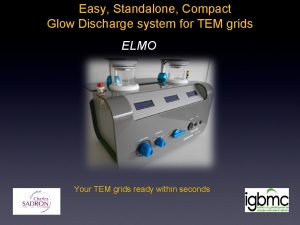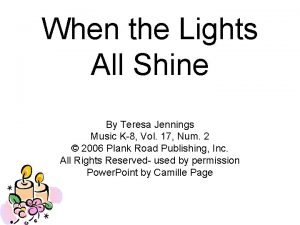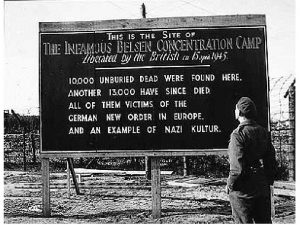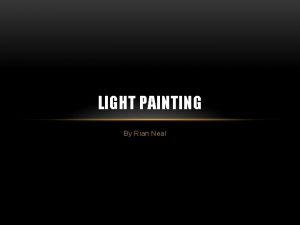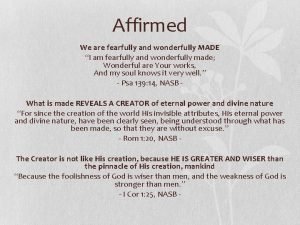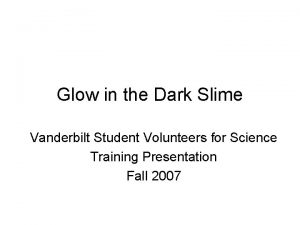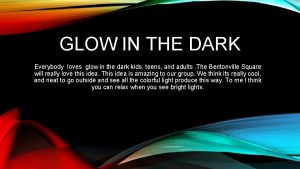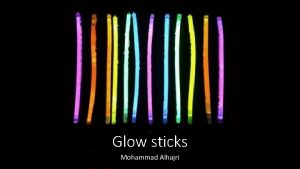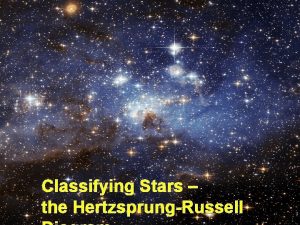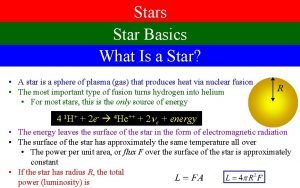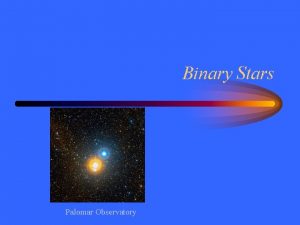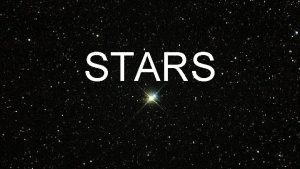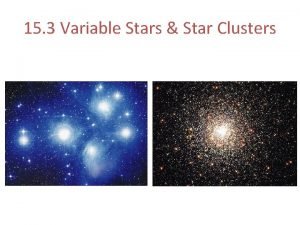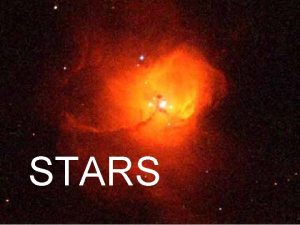Stars How does a Star Glow All stars






























- Slides: 30

Stars

How does a Star Glow? �All stars get their energy from FUSION �Fusion – combining of the nuclei of lighter elements (hydrogen) to form a heavier element (helium). �Fusion occurs in the core (middle) of a star.

Brightness Term #1 �Apparent Magnitude Measure of how bright a star appears to be to an observer on Earth. A low magnitude number means that the star is bright. The dimmest stars that can be seen with our eye have a magnitude 6. The Sun has a magnitude of -27, by far the brightest object in the sky.

Brightness Term #2 �Luminosity actual brightness of a star and depends on its surface area (size) and temperature. If two stars had the same temperature but different sizes; the larger star would have a greater luminosity. If two stars were the same size but had different temperatures, the hotter star would be more luminous.

Brightness Term #3 �Absolute Magnitude Measure of how bright the star would be if all stars were at the same distance from Earth. If you are moving the star closer to earth, it will be brighter. If you are moving the star farther from earth, it will be dimmer.

DEMO �Light Bulb Demo for understanding the difference between brightness terms! �Needed: 2 lamps, 3 similar light bulbs (2 with the same brightness), and 2 light bulbs with the same brightness but different size bulbs.

Composition of Stars �All stars consist mostly of hydrogen and helium �No two stars contain exactly the same elements in the same amounts. �Astronomers use spectral analysis from a spectroscope to determine a star’s composition.

Mass And Size Of Star � A star’s mass is something that we cannot observe directly. � We can calculate what a stars mass might be on the basis of other observations. it’s properties Gravitational influence on other objects. � Stellar Masses The mass of all stars is expressed as multiples of the mass of the sun. Sun’s mass is 1 solar mass. � Size Stars vary more in size than in mass. Smallest stars are smaller than Earth. Largest star known is 2000 times larger than our sun.

Color of a Star �Range of color a star emits depends on its surface temperature. Surface Temperature (C) Color Prominent Elements in Spectrum Above 30, 000 Blue Ionized Helium 9500 - 30, 000 Bluish white Neutral Helium 7000 - 9500 White Metals, Hydrogen 6000 - 7000 Yellow White Metals, Hydrogen 5200 - 6000 Yellow Metals, Hydrogen 3900 - 5200 Orange Metals, Hydrogen Below 3900 Red Titanium Oxide

Life Cycle of a Star �A Star is Born First…. . ▪ ▪ All stars begin in a nebula. A nebula is a large cloud of gas and dust. Gravity pulls the gas and dust together to form a protostar. Protostar is the earliest stage of a star’s life. Then…. ▪ The contracting gas and dust become so hot that nuclear fusion starts ▪ Once fusion starts a star is “born. ” ▪ Most stars become part of the main sequence at this point.

Death of a Small Star � Death of all Stars A star begins to die when it runs out of fuel (Hydrogen) Center of star shrinks and the outer part of the star expands becoming a giant What death the star will have depends on the mass of the star � Small Stars Small and medium sized stars end up as white dwarfs. Outer layers keep getting bigger and eventually drift into space. The blue-white hot core of the star is left. The core is called a white dwarf. Planetary nebula: glowing gas around a white dwarf. � White dwarf characteristics size of Earth and massive as the sun 1 million times as dense as the sun. When a white dwarf stops glowing it is dead, and called a black dwarf.

Death of a Medium Star �Dying giant star explodes. �The explosion is called a supernova �Material from the star can either create a new nebula to form new stars or form neutron stars. �Neutron Characteristics Smaller and denser than white dwarfs. 3 times the mass of the sun 20 km in diameter (same size as a town here) PULSAR- spinning neutron star.

Death of a Large Star �The supergiant explodes in a supernova explosion. �This leaves behind a black hole. �Characteristics of a Black hole Nothing can escape from a black hole. We can detect black holes by ▪ X-rays coming from the hot gas going into the black hole. ▪ Effect of the black holes gravity on a nearby star.

Length of a Star’s Life �How long a star lives depends on its mass. �Small stars use up their Hydrogen slower than large stars. Small stars can live for up to 200 billion years. Medium stars (sun) live for about 10 billion years. Larger stars can live for a few million years.

Life Cycles of Low Mass Stars � © Sea & Sky

Life Cycles of Massive Stars � © Sea & Sky

Activity: Lifecycle of a Star

H-R Diagram �Hertzsprung-Russell Diagram �Graph used to find out if temperature and brightness of a star are related. Temperature plotted on the X-axis Brightness plotted on the Y-axis Most stars form a diagonal band called the main sequence. ▪ Surface temperature increases as brightness increases. ▪ 90% of stars are main-sequence stars


�Activity: Classifying Stars!!

How Do Stars Make Elements? Sun generates energy in its core by “cooking” hydrogen to form helium. This is called nucleosynthesis.

Nucleosynthesis Protons and Neutrons are conserved. They fuse to form new elements. Requires and releases immense heat

Nuclear Fusion The “cooking” of elements is called nuclear fusion • During nuclear fusion, two or more atoms of one element combine to form one atom of a different element •

Conservation of Protons and Neutrons can not be created nor destroyed It is an addition problem!

Time to Practice!!!

Literacy � The Elements: Forged in Stars. (n. d. ). Retrieved August 24, 2016, from http: //www. pbslearningmedia. org/resource/ess 05. sci. ess. eiu. fus ion/the-elements-forged-in-stars/ Pre-Reading Activity: Read Background Essay and answer the following questions. 1. Create an illustration of an ordinary atom of Hydrogen as well as its isotope Deuterium. 1. What do you think the isotope of Hydrogen called Tritium looks like? Create a drawing to illustrate three steps in the nuclear fusion or nucleosynthesis process that creates the energy of the sun. 3. What is Helium capturing when it creates new elements? 2.

Elements in the Universe Hydrogen and some helium was made at the beginning of the Universe (Big Bang). • All other elements were made inside of stars, and then spewed out into space by the supernova explosions! • • • Low mass stars up to carbon • High mass stars up to iron What about elements with atoms heavier than iron? Such as Uranium, Gold, and so on? · The heavy atoms are made during the supernova explosion itself! · There is so much energy during the explosion that iron atoms can be forced together to form larger atoms.

Interior of a Massive Star Just before a supernova, the inside of the star has shells of various elements.

Supernova Remnants X-ray picture of the “Cas-A” supernova remnant. The elements in this gas will eventually be dispersed into space, maybe to form new stars, planets and people!

Using the Electromagnetic Spectrum to determine a star’s composition, motion and distance to Earth �Every substance gives off light when it gets hot enough. Each element gives off its own special color. (emission spectrum) We use spectra to determine which elements make up stars. �Motion and distance is determined by the amount of red shift. Red shift = moving away The farther the star the greater the red shift (Hubble’s Law)
 Star of wonder star of night star of royal beauty bright
Star of wonder star of night star of royal beauty bright Fccla star stands for
Fccla star stands for There are millions of stars in
There are millions of stars in Name all the lines name all the segments name all the rays
Name all the lines name all the segments name all the rays Difference between a star and ao star
Difference between a star and ao star Kentucky glow caverns
Kentucky glow caverns Health and glow online shopping
Health and glow online shopping When were glowsticks invented
When were glowsticks invented Green glass globe glow greenly
Green glass globe glow greenly Glow discharge system
Glow discharge system Warm glow altruism
Warm glow altruism Darvel primary school glow
Darvel primary school glow Minipcr dna glow lab answers
Minipcr dna glow lab answers The emigree analysis
The emigree analysis She walks in beauty analysis
She walks in beauty analysis Glow stick lab
Glow stick lab Echinops bannaticus the giant
Echinops bannaticus the giant Blender glow texture
Blender glow texture Kamoteng kahoy go grow glow
Kamoteng kahoy go grow glow When the lights all shine
When the lights all shine Tiny glow worm tenderness
Tiny glow worm tenderness Thank you for listening to my presentation
Thank you for listening to my presentation Glow gurt
Glow gurt The graceful slopes glow even clearer
The graceful slopes glow even clearer Rhyme glow
Rhyme glow Blinkin rev
Blinkin rev Glow-worms
Glow-worms Pals ett size
Pals ett size Apa itu gcs
Apa itu gcs In mrs tilscher's class annotated
In mrs tilscher's class annotated Glow inthe dark
Glow inthe dark









